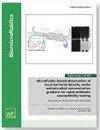Surface-dominant micro/nanofluidics for efficient green energy conversion
IF 2.4
4区 工程技术
Q2 BIOCHEMICAL RESEARCH METHODS
引用次数: 0
Abstract
Green energy conversion in aqueous systems has attracted considerable interest owing to the sustainable clean energy demand resulting from population and economic growth and urbanization, as well as the significant potential energy from water resources and other regenerative sources coupled with fluids. In particular, molecular motion based on intrinsic micro/nanofluidic phenomena at the liquid–solid interface (LSI) is crucial for efficient and sustainable green energy conversion. The electrical double layer is the main factor affecting transport, interaction between molecules and surfaces, non-uniform ion distribution, synthesis, stimulated reactions, and motion by external renewable resources in both closed nanoconfinement and open surfaces. In this review, we summarize the state-of-the-art progress in physical and chemical reaction-based green energy conversion in LSI, including nanoscale fabrication, key mechanisms, applications, and limitations for practical implementation. The prospects for resolving critical challenges in this field and inspiring other promising research areas in the infancy stage (studying chemical and biological dynamics at the single-molecule level and nanofluidic neuromorphic computing) are also discussed.用于高效绿色能源转换的表面主导微/纳米流体技术
由于人口、经济增长和城市化带来的可持续清洁能源需求,以及水资源和其他与流体耦合的再生资源的巨大潜在能量,水系统中的绿色能源转换引起了人们的极大兴趣。特别是,基于液固界面(LSI)固有微/纳米流体现象的分子运动对于高效和可持续的绿色能源转换至关重要。电双层是影响传输、分子与表面之间的相互作用、非均匀离子分布、合成、受激反应以及封闭式纳米融合和开放式表面中外部可再生资源运动的主要因素。在这篇综述中,我们总结了基于物理和化学反应的 LSI 绿色能源转换的最新进展,包括纳米级制造、关键机制、应用和实际应用的局限性。我们还讨论了解决该领域关键挑战的前景,以及启发其他处于起步阶段的有前途的研究领域(在单分子水平研究化学和生物动力学以及纳米流体神经形态计算)。
本文章由计算机程序翻译,如有差异,请以英文原文为准。
求助全文
约1分钟内获得全文
求助全文
来源期刊

Biomicrofluidics
生物-纳米科技
CiteScore
5.80
自引率
3.10%
发文量
68
审稿时长
1.3 months
期刊介绍:
Biomicrofluidics (BMF) is an online-only journal published by AIP Publishing to rapidly disseminate research in fundamental physicochemical mechanisms associated with microfluidic and nanofluidic phenomena. BMF also publishes research in unique microfluidic and nanofluidic techniques for diagnostic, medical, biological, pharmaceutical, environmental, and chemical applications.
BMF offers quick publication, multimedia capability, and worldwide circulation among academic, national, and industrial laboratories. With a primary focus on high-quality original research articles, BMF also organizes special sections that help explain and define specific challenges unique to the interdisciplinary field of biomicrofluidics.
Microfluidic and nanofluidic actuation (electrokinetics, acoustofluidics, optofluidics, capillary)
Liquid Biopsy (microRNA profiling, circulating tumor cell isolation, exosome isolation, circulating tumor DNA quantification)
Cell sorting, manipulation, and transfection (di/electrophoresis, magnetic beads, optical traps, electroporation)
Molecular Separation and Concentration (isotachophoresis, concentration polarization, di/electrophoresis, magnetic beads, nanoparticles)
Cell culture and analysis(single cell assays, stimuli response, stem cell transfection)
Genomic and proteomic analysis (rapid gene sequencing, DNA/protein/carbohydrate arrays)
Biosensors (immuno-assay, nucleic acid fluorescent assay, colorimetric assay, enzyme amplification, plasmonic and Raman nano-reporter, molecular beacon, FRET, aptamer, nanopore, optical fibers)
Biophysical transport and characterization (DNA, single protein, ion channel and membrane dynamics, cell motility and communication mechanisms, electrophysiology, patch clamping). Etc...
 求助内容:
求助内容: 应助结果提醒方式:
应助结果提醒方式:


